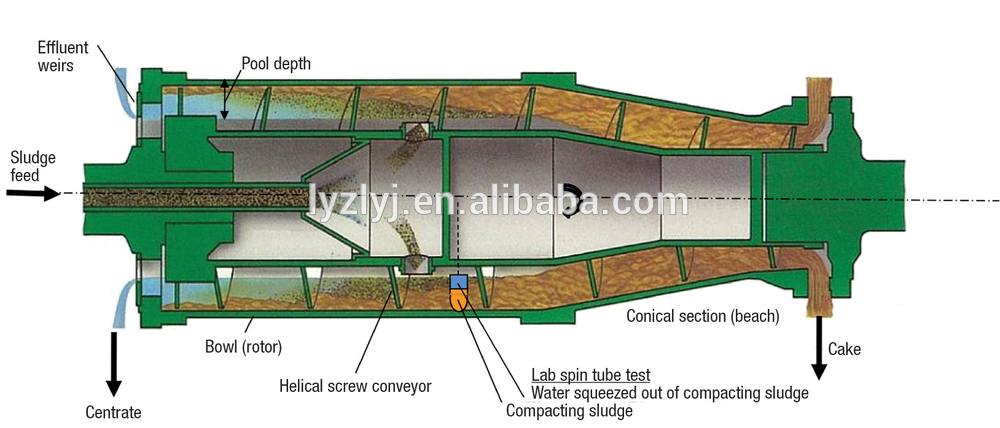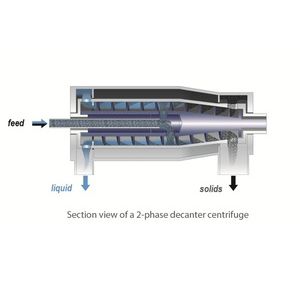The Laboratory and small scale capacity decanter centrifuge are typically used in the food
and fermentation industries, the chemical and pharmaceutical industries and in biotechnology.
In addition to their use in R&D departments, Lemitec decanter centrifuges have also been
successfully used over long periods in the production of high-quality products requiring material
flows of less than 1000 L/h.
The Laboratory and small scale capacity decanter centrifuge can also be used as measuring
instruments to obtain data on the flow properties of individual product phases. The flow behaviour
of the product stream and the change in the torque between the bowl and the scroll are displayed
on the control panel of the decanter centrifuge as a function of the power consumption of the drive
motors and recorded, thus enabling the flow behaviour to be evaluated for the purpose of modelling
decanter applications.
Bowl Diameter 150 mm
Centrifugal force 7000 g
Sludge conveying torque 3600 N.m
Capacity 0.1to 1m³/h
Power 4.0 kw
Weight 300 kg
Dimensions 1000×700×800 mm
A modern decanter centrifuge designed for 2-phase (solid-liquid) separation operations
and for product streams of up to 1000 L/h.
The Laboratory and small scale capacity decanter centrifuge series were developed
specifically as two-phase decanter centrifuges for use in laboratories and pilot plants
to enable small quantities of products to be processed at rates of between 1 L/h to
1000 L/h in a continuous separation operation.
The minimum throughputs of industrial decanter centrifuges are generally far greater than
the throughputs required for the quantities of products available in research laboratories.
In the past, the processing stage of continuous separation therefore frequently had to be
simulated with alternative batch-wise separation methods
Separation takes place in a horizontal cylindrical bowl equipped with a screw conveyor.
The feed enters the bowl through a stationary inlet tube and is accelerated smoothly by
an inlet distributor. The centrifugal force that results from the rotation then causes
sedimentation of the solids on the wall of the bowl.
The conveyor rotates in the same direction as the bowl, but at a different speed, thus
moving the solids towards the conical end of the bowl. The cake leaves the bowl through
the solids discharge openings into the casing. Separation takes place throughout the
entire length of the cylindrical part of the bowl,and the clarified liquid leaves the bowl by
flowing over adjustable plate dams into the casing.

The bowl comprises a cylindrical and a conical section and rotates at a speed appropriate for the
separation operation. Centrifugal force causes the solids present in the suspension to be deposited
on the wall of the bowl.
The scroll, which has the same cylindrical/conical shape as the bowl, rotates at a slightly higher speed
(differential speed) than the bowl. This causes the separated solids to be conveyed towards the narrow conical end of the bowl where they are expelled through outlets and discharged. The extent to
which the solids are dewatered depends, amongst other things, on the length of time they are
exposed to the centrifugal force in the bowl. The time taken for the solids to be conveyed through the
bowl can be set as appropriate for the type of separation operation by altering the differential speed.
A weir disc that can be set exactly as required is fitted at the end of the cylindrical section of the bowl.
The clarified liquid flows along the scroll thread to the cylindrical end of the bowl and out over the weir
plate, after which it is collected in the casing and discharged. The depth of the clarified liquid in the bowl can be adjusted to exactly the level required by inserting different weir discs.
1.cost-effective performance
2.reduces sludge volume, which cuts down on transport and disposal costs
3.continuous operation
4.compact, modular design saves space
5.low installed power reduces electricity consumption
6.the bowl speed to ensure the exact G force required for the most efficient separation
7.the conveying speed for the best possible balance between liquid clarity and solids dryness
8.the pond depth in the bowl for the best possible balance between liquid clarity and solids dryness


 China
China
